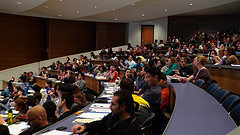from a student’s view – large classes

this is a guest post by emily garcia, vanderbilt class of 2014, college of arts and sciences. the post is part of our ongoing “from a student’s view” blog series. we occasionally feature guest posts here on the blog as part of our efforts to cultivate dialogue about teaching and learning among vanderbilt faculty, students, and staff. we recognize that everyone’s teaching context is different, but we hope that hearing others’ perspectives on teaching and learning will help our readers reflect on their own teaching. if you would like to contribute a guest post, please let us know.
i recently had the chance to talk with leah carlisle and sylvia precht-rodriguez, both current vanderbilt sophomores who took the same large social science class last semester. they knew what they were getting into when signing up for the course. with over 170 reviews on ratemyprofessor.com about the instructor, who has a reputation around campus as being everything from “a difficult grader” to “a classic vandy professor that everyone has to take,” leah and sylvia had lots of information about this professor’s courses.
leah and sylvia knew that this class was one of those with a large enrollment—this course numbered over 200 students. quizzes are given weekly on the material from lecture and the readings, unless it’s a week with a paper or exam. the other portion of a student’s grade comes from attendance and participation in class. this seems natural for most classes, but i wondered how does one measure attendance and participation in a class sized over 200 students?
the answer lies in technology. the course requires that each student purchase or borrow a clicker to use in class. students’ responses to questions posed throughout the lecture are recorded by a receiving device in the professor’s computer, and the percent of questions responded to over the semester determines the student’s participation grade. i noticed that this method received mixed responses from the students i talked to. leah, a human and organizational development and economics double-major, saw the use of clickers as “an efficient way to see attendance and get students to pay attention to at least parts of the lecture.” political science and economics double-major sylvia thought that the clickers were interesting to use in class because of the opportunity to see the class’s answers. however, she thought that participation grades should be determined by “actual participation.” sylvia cited paying attention, taking thorough notes, and asking questions as good metrics for measuring participation; though, the nature of a large class means that the professor cannot realistically keep track of this without help.
having such a full classroom meant that some other issues arose as well. the motivation to attend class varied from student to student, as it does in most courses, but accountability lags in a large room. leah and sylvia were certainly not strangers to large classes and knew that their presence would not be missed if the other 200+ students showed up to lecture. they had each taken at least five classes with enrollment over 50 students and knew when it was necessary or not to attend class.
the motivation for leah and sylvia typically came from their interest in the subject, something that varies as well. use of the clickers had varying success in motivation and attendance, but as sylvia noticed, “the participation points are so few and were not enough to motivate attendance every day.” the impression that i got from leah and sylvia was that the professor was an exciting lecturer, so their interest was usually high. the professor tended to bring up current events and used real life examples in his teaching, both effective methods for holding students’ attention.
overall, i got the impression from leah and sylvia that this class was seemingly a daunting size, but the strategies employed by the experienced teacher –clickers, exciting teaching, and a wide variety of helpful resources– offset the dangers of a large class size.
upcoming cft conversation on teaching:
teaching large classeshow do you personalize interaction in a class with more than 100—or even more than 200—students? how do you promote student engagement when it’s so easy for a student to hide in the crowd? how do you provide helpful feedback without burying yourself with grading?
this conversation on teaching will provide a forum for vanderbilt instructors to share some of the strategies they have developed or adapted from the literature to deal with the challenges of large classes. three faculty panelists will kick-start the conversation by describing some of their successful strategies and ongoing challenges:
- carl johnson
stevenson professor, biological sciences- sandra rosenthal
jack and pamela egan chair, chemistry- andrew van schaack
assistant professor of the practice, department of human and organizational development



leave a response